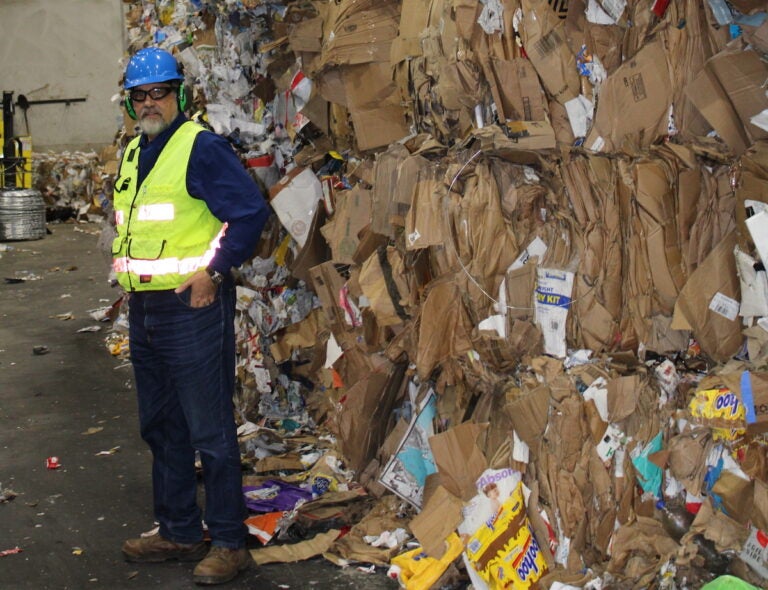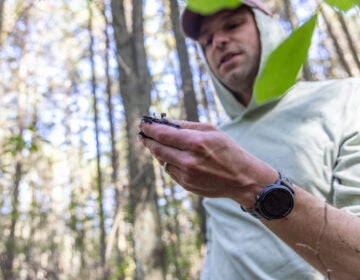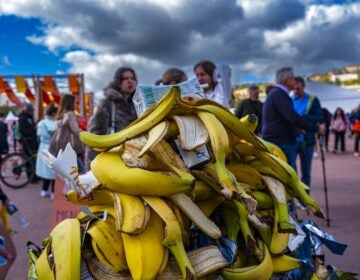Some researchers say plastic recycling is a 'fraud' — What do we do now?
Only about five percent of plastics produced annually are recycled in the U.S. So how much plastic is five percent? And will recycling that amount make a difference?
Listen 11:00
Environmental consultant Wayne DeFeo surveys the daily collection at the Robert C. Shinn, Jr. Recycling Center in Westampton, NJ. (Grant Hill/WHYY)
This story is from The Pulse, a weekly health and science podcast.
Find it on Apple Podcasts, Spotify, or wherever you get your podcasts.
When I called Wayne DeFeo and told him I was considering giving up on recycling plastic, I received the kind of blunt pushback one might expect from an environmental consultant based in New Jersey.
“You’re just wrong,” DeFeo told me.
DeFeo is a former middle school science teacher who now educates organizations on improving their waste management systems.
“It’s frustrating to watch, where there are litter baskets on the street where you’re walking through a downtown, and then you have a recycling bin next to that litter basket that looks very nice, [but] they’re both full of the same thing,” DeFeo said. “That’s a failure of recycling.”
DeFeo seemed like the perfect person to address my ongoing crisis of confidence in plastic recycling.
I explained to him how, like others now in their 20s, I was taught recycling was just as important as voting and paying taxes. From airplanes to fast food drive-thrus and durable shoes, our lifestyle depended on colorful, lightweight, nearly eternal plastic resins. So everyone had to do their fair share to keep these materials in circulation and out of landfills and waterways.
Together, plastic could be clean and sustainable.
But, thanks to a recent spate of investigations, my faith has been waning.
“This [was a] broader campaign to make us believe that plastic recycling was more viable than it actually was,” said Davis Allen, an investigative researcher for the Center for Climate Integrity.
The rise of recycling
Earlier this year, Allen co-authored a report that reveals new details about the inner workings of what he calls a decades-long fraud.
“It’s been very effective in that people have really taken it to heart and genuinely believed that that was a way that they could make a difference.”
The report is based on internal industry documents showing how the plastics industry dubiously promoted recycling in response to the growing outcry over waste.
“I think what’s clear is that going back a long, long time, there was a pretty good sense among people who were aware of the situation that recycling just wasn’t a viable solution for most plastic products,” Allen said.
Plastic was long heralded as a miracle material in the U.S. — a shapeshifter that could morph into anything from clear bags to lampshades and storage boxes. In the 1950s and 1960s, plastic resin producers worried little about what happened when its miracles ran out. The material was lauded for its durability and reusability. When panic spread after dozens of children suffocated on plastic dry cleaner covers in 1959, the industry pivoted toward “single-use” plastic products. It was a lucrative course correction.
“Until the late 60s, early 70s, there really wasn’t much interest in or concern about plastics disposal, at least among people in the industry,” said Allen. “The idea was that markets were growing dramatically, in large part based on single-use disposable plastic products, especially plastic packaging. And they just weren’t very concerned about what happened to it afterwards.”
Subscribe to The Pulse
Most plastic was destined for landfills or incinerators.
“But 1970 was the first Earth Day [and] people began to be concerned about environmental problems in a sort of different way than they had been before,” Allen said.
By the mid-1980s, the plastic waste problem had ballooned out of control and was impossible to ignore.
As a result, lawmakers at almost every level proposed legislation to control, or completely ban, single-use plastic.
In response, the plastics industry launched a multi-faceted public relations campaign via front groups and foundations centered around a new concept: recycling.
“The effort really took a wide variety of forms, and they were targeted at different audiences,” said Allen. “They were targeting the public, they were targeting lawmakers, they were targeting the media. It was really a widespread effort. But it was very effective.”
Decades earlier, industry insiders who had already explored recycling as a solution quietly deemed the economics “virtually hopeless.” Still, the industry engaged in what one trade association staffer called grassroots “guerrilla warfare,” funding advertising campaigns, lobbying politicians, and distributing lesson plans about recycling for children.
“In many cases, those lawmakers that had been considering recycling bills or outright bans, the industry used their investments and their trade organizations and all of these advertising materials, everything basically to convince them: ‘Don’t do it yet. Wait, let’s see what happens, let us show you that we can make this work.’ And then they avoided bans as a result.”
The campaign sought to ease concerns and make consumers feel like a part of the solution.
In 1988, the Society of the Plastics Industry created the Resin Identification Codes that mark many plastic consumer products today. The numerical system was ostensibly devised to help make recycling more efficient.
“They claimed that it was a way to improve recycling by making it more clear what kind of plastic resin was in a given product,” Allen said.
But recycling advocates warned the system would only lead to confusion and pollute recycling collections by giving consumers the mistaken belief that all products bearing the “chasing arrows” symbol were or could be recycled.
Allen, and the U.S. Environmental Protection Agency, said deception was the point.
“Unfortunately, the industry was really successful in getting a large number of states to pass legislation requiring those symbols to be added. And then ultimately, we get the system like we have today where you know virtually every plastic product you see has some kind of recyclable symbol on there,” Allen said.
The American Chemistry Council, a plastics industry group, claims the Center for Climate Integrity report is “flawed” and highlights out-of-context and “outdated” information.
A spokesperson for the group said the ICC report downplayed recent developments in “advanced” recycling, a term used to describe multiple chemical processes that have complemented old-fashioned mechanical recycling on a small scale for decades.
But “advanced” recycling has yet to reduce the plastic waste problem significantly, and it may just create new ones.
Allen told me the results speak for themselves.
“The recycling rate in the U.S. is unfortunately really low,” Allen said.
Only about five percent of plastics produced annually are recycled in the U.S. Globally, only 30% of all the plastic ever produced is estimated to still be in use. And more plastic is produced now than ever before.
So how are individuals supposed to respond? Just continue to feel like a dupe for sifting through our trash and leaving out those blue bins all for a measly five percent? Is it all some sad performance that we’re better off leaving behind?
Mountains of plastic
I posed these questions to recycling consultant Wayne DeFeo. DeFeo was well aware of the recycling rates. He didn’t ask for this system, but he inherited it, and he wanted it to work as well as possible.
He invited me to my local recycling processing plant in Burlington County, New Jersey. It is one of the oldest recycling programs in the state, and the plant was first built in the 1960s to employ adults with developmental disabilities.
Today, it is a sprawling orchestra of refuse, a maze of whizzing, crisscrossing conveyor belts, wheels, sensors, and tiny compressed-air canons that spin, fling, and sort through metal, cardboard, paper, glass, and three kinds of plastic.
The first step is quality control. He pointed to a toaster off to the side.
“The people here pull off anything they see that doesn’t belong here, like a toaster. Why there’s a toaster in there, I couldn’t tell you, but it shouldn’t be there,” DeFeo said.
Alongside the humming machinery, dozens of workers sort through this steady stream, removing what the instruments missed.
DeFeo told me it’s a dangerous job. Bins are often carelessly filled with trash that shouldn’t be there.
Thermal cameras weed out misplaced batteries inside piles of material, which, if punctured or compressed, could spark a fire that burns the whole place down in minutes.
Used needles have sent workers to the hospital.
DeFeo held up a sword once picked out of a daily collection.
As we made our way through the facility that Wayne compares to the game Mouse Trap, I felt my throat tighten and my eyes water.
I blamed it on the smell — sour milk on an industrial scale.
To give you context, this facility can process, sort, clean up about 35 tons of material every hour.”
After half an hour of climbing stairs and weaving through processors, we reached the end of the line — where a mountain of compressed plastic bails, 99% pure material, waited to be shipped to another processing plant, where it would be melted down and sold to the highest bidder.
The state’s eleventh-most-populated county produced this mountain in less than one day. It is, simply put, an unthinkable amount of plastic.
The cycle repeats until the resin becomes too degraded to make the journey, at which point, what remains is finally sent to a landfill.
“Why are we here? Because it’s a combination of two things. Consumers like convenience, and manufacturers make things to meet that consumer convenience — but also sell us and tell us what we want, and we buy into it,” DeFeo said.
He knows our world is drowning in plastic, and that this orchestra, no matter how remarkable, won’t save us.
Last year, the United Nations began work on a global treaty to end plastic waste. But it’s far from finished.
For now, the recyclers play on, toiling away in these hot, stenchy plants as those who caused this mess furnish their lifeboats.
DeFeo reassures me that this is why everyone must continue to play their part, and fill those blue bins, despite the system’s faults — the greenwashing and false promises.
Rather than curse how little plastic gets recycled, DeFeo told me to treasure just how much really does.
WHYY is your source for fact-based, in-depth journalism and information. As a nonprofit organization, we rely on financial support from readers like you. Please give today.







